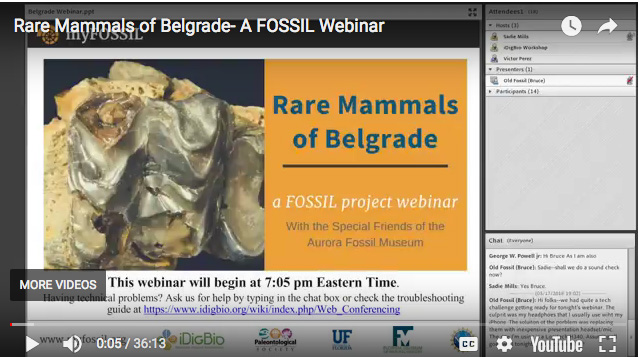By Hunter Thurmond
I don’t often complete surveys, but when completion means the chance to participate in a citizen science dig with The FOSSIL Project looking for extinct rare land mammals, I’m a little more eager. Ok very eager to fill out this survey. And I was selected! The FOSSIL Project was going to bring me out to New Bern, North Carolina for a citizen science project and the Aurora Fossil Festival. Up until this point I knew no one else who collected fossils or had any interest in paleontology, but they told me there would be thousands of fossil lovers in the tiny town of Aurora for the festival.

A few weeks before the big weekend, Dr. Bruce MacFadden, Florida Museum paleontologist, gave a webinar outlining the dig site information and what we would be looking for, rare land mammals! I had only recently become interested in sharks teeth, but the webinar had examples of shiny mammal teeth of which I had never seen. Dr. MacFadden explained that the Martin Marietta quarry at Belgrade had created 5 special piles of sediment taken specifically from a dark portion called the Belgrade Formation. He referenced a free paper by Lauck Ward who was also participating in the dig. Dr. MacFadden explained the early Miocene fossils at Belgrade were closely related to fossils found in Nebraska and by himself recently in Panama. The ultimate goal was to acquire enough fossils to determine whether Belgrade was a habitat more similar to the tropical example in Panama or the dry example in Nebraska. That’s where citizen science comes in to play; by allowing everyday citizens like myself to participate in the joy of discovery, fossils can be found more rapidly.
In the webinar Dr. MacFadden showed us renditions of the early Miocene, or Arikareean Land Mammal age as he referred to it. The giant Daeodon really caught my imagination, how cool would it be to hold a tooth of this Arikareean 20 million year old beast. He had been referring to them as rare fossils for a reason. The true sparsity I could not comprehend at the time, although other fossils being very plentiful. When we got to the quarry they gave us a safety lesson and waivers to sign, and we were off to collect. Bruce reminded us what we were looking for and for the next few hours FOSSIL Project participants and the Special Friends of the Aurora Fossil Museum (SFAFM) dug through the piles and sifted our hearts out. The SFAFM helped The FOSSIL Project setup the Belgrade formation dig with the Martin Marietta quarry. Many variety of teeth were found from sharks, cetaceans, fish, crocodilians, but only a few were found from the desired rare land mammals. Dr. MacFadden said one may have been a camel tooth but they are still going through the many fossils we produced that day. All the fossils we found were bagged, labeled, and donated to the Florida Museum of Natural History as part of our citizen science project. The FOSSIL Project later had the fossils sorted by other citizen science participants, increasing the level and spread of citizen involvement.


What might it mean for the habitat argument if camel teeth are present at Belgrade? Does that mean Belgrade was a more dry climate like that of similar age in Nebraska? Maybe camels of this age didn’t live in dry climates, or maybe it is not a camel tooth at all! I love letting my imagination chase an answer; there are so many scenarios to explore, each one a possible picture of the past.

After we wrapped up our project at Belgrade, we were off to the festival opening ceremony. The more experienced collectors on the trip had been here before and introduced me to the museum and spoil piles. Yes, right there at the museum were more piles of fossils to hunt through. I sat in the piles next to Victor Perez, a grad student at the University of Florida and part of the FOSSIL Project, who was able to identify almost all the shark teeth I pulled out of the piles. The next day the Festival really kicked off with many organizations including The FOSSIL Project having educational booths. Dana Ehret gave a talk on shark paleontology which was like being a student for a day for many amateurs, an opportunity they all valued. I personally left this wonderful opportunity The FOSSIL Project offered to me with just as much excitement as I had arrived with, and with many more opportunities to participate in paleontology in the future.

To learn more:
You can access a recording of the Belgrade webinar here.